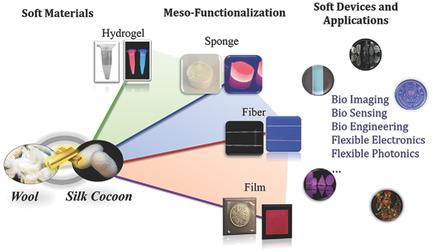Our official English website, www.x-mol.net, welcomes your
feedback! (Note: you will need to create a separate account there.)
Mesoscopic‐Functionalization of Silk Fibroin with Gold Nanoclusters Mediated by Keratin and Bioinspired Silk Synapse
Small ( IF 13.0 ) Pub Date : 2017-09-01 , DOI: 10.1002/smll.201702390 Yao Xing 1, 2, 3 , Chenyang Shi 1 , Jianhui Zhao 4 , Wu Qiu 1 , Naibo Lin 1 , Jingjuan Wang 4 , Xiao Bing Yan 4 , Wei Dong Yu 2 , Xiang Yang Liu 1, 3
Small ( IF 13.0 ) Pub Date : 2017-09-01 , DOI: 10.1002/smll.201702390 Yao Xing 1, 2, 3 , Chenyang Shi 1 , Jianhui Zhao 4 , Wu Qiu 1 , Naibo Lin 1 , Jingjuan Wang 4 , Xiao Bing Yan 4 , Wei Dong Yu 2 , Xiang Yang Liu 1, 3
Affiliation

|
Silk fibroin (SF) offers great opportunities in manufacturing biocompatible/partially biodegradable devices with environmental benignity and biomedical applications. To obtain active SF devices of next generation, this work is to demonstrate a new functionalization strategy of the mesoscopic functionalization for soft materials. Unlike the atomic functionalization of solid materials, the meso‐functionalization is to incorporate meso‐dopants, i.e., functional molecules or nanomaterials, quantum dots, into the mesoscopic networks of soft materials. In this work, wool keratin (WK) molecules were adopted as mediating molecules to incorporate gold nanoclusters (AuNCs), into the mesoscopic networks of SF. It follows from our analyses that the β‐crystallites between WK and SF molecules establish the binding between WK@AuNCs and the SF networks. The incorporated WK@AuNCs are electron rich and serve as electronically charged nano particles to bridge the growth of Ag filaments in bio‐degradable WK@AuNCs–SF memristors. The meso‐functionalization can greatly enhance the performance of SF materials and endows them with new functionalities. This can be highlighted by biocompatible/partly degradable WK@AuNCs functionalized SF resistive random‐access memories, having the enhanced resistive switching memory performance, and the unique synapse characteristics and the capability of synapse learning compared with neat SF devices, and of great importance in nonvolatile memory, analog circuits, and neuromorphic applications.
中文翻译:

丝素蛋白的介观功能化与角蛋白和生物启发的丝突触介导的金纳米团簇。
丝素蛋白(SF)在制造具有环境良性和生物医学应用的生物相容性/部分可生物降解的设备方面提供了巨大的机会。为了获得下一代有源SF设备,这项工作是为了演示软材料的介观功能化的新功能化策略。与固体材料的原子功能化不同,介观功能化是将介杂掺杂剂(即功能分子或纳米材料,量子点)并入软材料的介观网络中。在这项工作中,采用羊毛角蛋白(WK)分子作为介导分子,将金纳米团簇(AuNCs)掺入SF的介观网络中。从我们的分析可以看出,WK和SF分子之间的β微晶建立了WK @ AuNCs与SF网络之间的结合。结合的WK @ AuNCs具有丰富的电子,可作为带电的纳米粒子,以桥接可生物降解的WK @ AuNCs-SF忆阻器中Ag细丝的生长。介观功能化可以极大地提高SF材料的性能,并赋予它们新的功能。生物相容性/可部分降解的WK @ AuNCs功能化SF电阻随机存取存储器可以突出显示这一点,与纯净SF设备相比,具有增强的电阻开关存储器性能,独特的突触特性和突触学习能力,在非易失性存储器,模拟电路和神经形态应用。介观功能化可以极大地提高SF材料的性能,并赋予它们新的功能。生物相容性/可部分降解的WK @ AuNCs功能化SF电阻随机存取存储器可以突出显示这一点,与纯净SF设备相比,具有增强的电阻开关存储器性能,独特的突触特性和突触学习能力,在非易失性存储器,模拟电路和神经形态应用。介观功能化可以极大地提高SF材料的性能,并赋予它们新的功能。生物相容性/部分可降解的WK @ AuNCs功能化的SF电阻随机存取存储器可以突显这一点,与纯净的SF设备相比,具有增强的电阻开关存储器性能,独特的突触特性和突触学习能力,并且在非易失性存储器,模拟电路和神经形态应用。
更新日期:2017-09-01
中文翻译:

丝素蛋白的介观功能化与角蛋白和生物启发的丝突触介导的金纳米团簇。
丝素蛋白(SF)在制造具有环境良性和生物医学应用的生物相容性/部分可生物降解的设备方面提供了巨大的机会。为了获得下一代有源SF设备,这项工作是为了演示软材料的介观功能化的新功能化策略。与固体材料的原子功能化不同,介观功能化是将介杂掺杂剂(即功能分子或纳米材料,量子点)并入软材料的介观网络中。在这项工作中,采用羊毛角蛋白(WK)分子作为介导分子,将金纳米团簇(AuNCs)掺入SF的介观网络中。从我们的分析可以看出,WK和SF分子之间的β微晶建立了WK @ AuNCs与SF网络之间的结合。结合的WK @ AuNCs具有丰富的电子,可作为带电的纳米粒子,以桥接可生物降解的WK @ AuNCs-SF忆阻器中Ag细丝的生长。介观功能化可以极大地提高SF材料的性能,并赋予它们新的功能。生物相容性/可部分降解的WK @ AuNCs功能化SF电阻随机存取存储器可以突出显示这一点,与纯净SF设备相比,具有增强的电阻开关存储器性能,独特的突触特性和突触学习能力,在非易失性存储器,模拟电路和神经形态应用。介观功能化可以极大地提高SF材料的性能,并赋予它们新的功能。生物相容性/可部分降解的WK @ AuNCs功能化SF电阻随机存取存储器可以突出显示这一点,与纯净SF设备相比,具有增强的电阻开关存储器性能,独特的突触特性和突触学习能力,在非易失性存储器,模拟电路和神经形态应用。介观功能化可以极大地提高SF材料的性能,并赋予它们新的功能。生物相容性/部分可降解的WK @ AuNCs功能化的SF电阻随机存取存储器可以突显这一点,与纯净的SF设备相比,具有增强的电阻开关存储器性能,独特的突触特性和突触学习能力,并且在非易失性存储器,模拟电路和神经形态应用。











































 京公网安备 11010802027423号
京公网安备 11010802027423号